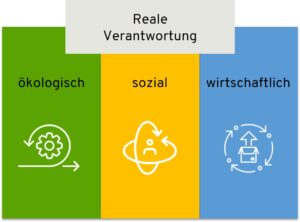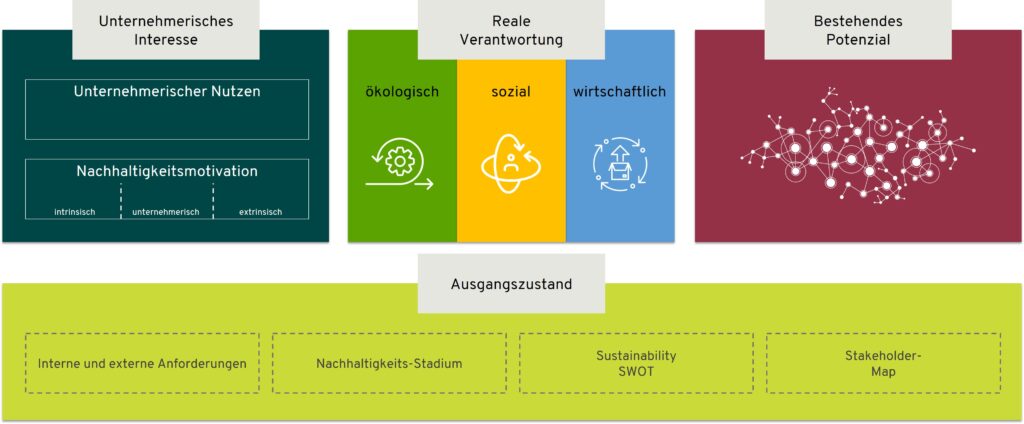Like any other strategy, a Sustainability strategy in companies provides a solid foundation on which to build. However, a company's commitment to sustainability cannot only be measured by its proportionate annual profit. It must also fulfil the requirements of important Stakeholders to do justice to them. And above all, it should improve the company's actual impact on the environment and society.
A solid foundation is therefore all the more crucial for establishing a clear and targeted sustainability strategy. Clear and targeted means that it brings benefits both in business terms and in terms of social and environmental aspects.
This article can be found together with others in our Comprehensive guidelines for the development of a sustainability strategy. This is intended to provide a complete overview of the topic.
Contents:
- 3 dimensions as the basis for the strategy
- Dimension 0: Initial state of sustainability
- Dimension 1: Corporate interest in sustainability
- Dimension 2: real responsibility towards society and the environment
- Excursus materiality analysis
- Dimension 3: The existing potential for sustainability
- Conclusion
From our experience, 3 dimensions need to be worked out:
- The entrepreneurial interest in Sustainability
- The company's real responsibility towards people and nature
- The existing potential for sustainability in the company that can be built upon
In the following, we show the options and modules that can be used to tap into these three dimensions. Which modules are suitable depends on the company in question. It may also make sense to modify the approaches and proceed differently depending on a company's situation.
Last but not least, the steps and approaches are never clear-cut, nor could they be. Experience has shown that every new insight into corporate sustainability sharpens the focus so that previous considerations can then be carried out in more detail or more contextually.
Dimension 0: Determine the initial status of the sustainability strategy in the company
In most cases, it helps to first develop an understanding of where the company stands in the context of sustainability. To do this, it helps to take a look at the past, existing models for categorisation and the system in which the company operates. This understanding helps to establish the important broader view of sustainability within the company. This is therefore the basis of any sustainability strategy in a company.

Include existing internal and external requirements
- Results of employee surveys, opinions from management, feedback from recruiting and marketing
- Receivables from shareholders, parent companies, etc.
- Demands from NGOs, consumer organisations and others
- Requirements from the competition and the market in terms of sustainability
- Legal requirements such as CSR-RUG, NAP etc.
Recognising what stage of sustainability the company is at
There are various models that depict a typical progression of companies in the area of sustainability or CSR. All of them attempt to help recognise where a company already stands and where it wants to go. The sustainability strategy in companies is itself only one part of the analysis.
A simple and widely suitable model is the Sustainability Stages of the Global Compact. It shows in 5 stages how a company develops from reactive sustainability crisis management to an integrated understanding of sustainability.

The entire concept can be found in the LEAD Programme of the Global Compact.
However, we recommend taking a more differentiated approach. If an attempt is made to place the entire company in such a model, this usually does not do justice to reality. Instead, a company should form suitable sustainability aspects that can be categorised individually in the model. For example Climate protection, working conditions, diversity or resource conservation.
Carry out a sustainability SWOT analysis
The classic SWOT analysis is a familiar tool for many companies. In order to build on what is familiar, companies can now modify the SWOT analysis and specify it for sustainability. In this way, the topic of sustainability strategy in companies is developed using familiar means. The aim is an initial categorisation of the topic in the strategic corporate context of the company.
Draw up a stakeholder map
To find out which groups have an interest in the company's activities or are even affected by them, it is a good idea to draw up a stakeholder map. This can be used to collect internal and external stakeholders, for example. It then helps to describe what interests they have in the company's activities. Finally, the company can evaluate them. For example, according to how much influence they have on the company and how much influence the company has on them.
Methods and best practice for sustainability in your mailbox

Dimension 1: entrepreneurial interest - motivation and business case for sustainability
In business ethics (e.g. between Vaaland and Friedmann), there is a justified debate as to whether sustainability should or may be developed by companies with a view to economic benefits. In practice, it is clear that the vast majority of companies have to justify their sustainability activities internally or externally in economic terms. It is therefore important to emphasise precisely this economic basis. The initial situations can be as diverse as the companies and sectors themselves.
The motivation for sustainability is the starting point and the entrepreneurial potential is the orientation for the design.

Honestly work out your own motivation for sustainability
We have found that companies' motivations for sustainability can be roughly categorised into three groups, each of which forms a different starting point for the subsequent strategy.
Intrinsic motivation of the management
- Opportunities: authenticity, enthusiasm, quickly becoming part of the culture
- Risks: blind idealism, high costs, frustration
Entrepreneurial motivation
- Opportunities: Effective and targeted development of sustainability, attractiveness of the topic through profitability
- Risks: Greenwashingtoo strongly anchored in communication
Extrinsic motivation through regulations, customer requirements, etc.
- Opportunities: cost-efficient implementation
- Risks: Greenwashing (high), no ROI
Our recommendation is not to base a sustainability strategy in companies on purely extrinsic motivation. If intrinsic motivation is primarily identified, it may also be worthwhile to awaken entrepreneurial motivation. If entrepreneurial motivation is identified as a priority, it is worth working on building up intrinsic management motivation in the medium term.
Identifying the business benefits of sustainability
To find out how sustainability can contribute to corporate development, it is worth looking at various aspects:
- What goals does the corporate strategy pursue and to which of these can sustainability activities contribute?
- What specific benefits would be desirable? E.g. employer attractiveness, differentiation from competitors, innovation incentive, branding, financing facilitation through sustainable finance criteria
- What trends can be identified that speak in favour of a commitment to sustainability? For example, the neo-ecology megatrend or the media trends "climate targets" 2020, "plastic waste" (2019), "insect extinction" 2018.
- What can a "business case for sustainability" look like in a company? How can money be earned with it? What new markets can be opened up?
Dimension 2: Real responsibility - substantive basis for the sustainability strategy in companies
In addition to the economic incentive for sustainability in the company, real responsibility from a social perspective plays an even greater role. This means finding out which resources a company uses and where there is a risk of overuse. Resources here include natural resources (wood, metal, sand, oil, etc.) as well as human resources (health, labour, etc.) and intangible resources (trust, enthusiasm, etc.). From this perspective, a company should work most intensively on the resources that are most at risk.
As the resources are very different, it is necessary to apply separate survey procedures for each of them. These methods help to assess the areas in which the company bears a particularly large responsibility. When analysing the use of material resources, quantifying methods for recording material flows and impacts are particularly suitable. When analysing the use of human and non-material resources, questioning, comparative, but also partly quantifying methods are suitable.

Survey of ecological responsibility - Material resource utilisation
- Firstly, a company must understand its own value creation cycle (also known as the product life cycle). For all materials used, an attempt is made to find out the origin, type of extraction, processing locations and processes as well as the method of use by customers and the method of disposal. Depending on the product, the auxiliary or process materials used (e.g. energy in metal production) play a particularly important role. The use of material resources also plays a role for services. For example, the use of server services can have a significant impact on energy and material consumption.
- The materials used are then identified along the steps of the life cycle. This often includes water, waste water or sealed surfaces.
- If the substances used are known, they can be quantified and cumulative values can be calculated for each product, e.g. water used (also known as "virtual water"), total energy consumption or derived CO2 emissions. The most precise but also the most time-consuming survey is a life cycle assessment.
Survey of social responsibility - human, non-material and social resources
- Social responsibility is more diverse and, for many companies, more complex than environmental responsibility.
- The first step is to build on the identified value creation cycle. If it is known where the product or service is in the course of its "life", it becomes clearer which people it affects. For example, the wage conditions in production or the working conditions during material extraction.
- Companies often take too superficial a view of the product utilisation phase. Customers are often linked to larger social systems that can also be affected.
- Quantitative approaches to HR management can now be used to analyse the use of human resources quite precisely.
- The identification of utilised non-material and social resources can take place via the screening of studies on public opinion, exchange with experts on the topics or own surveys.
- In all cases, a broadly organised Stakeholder dialogue on. The company should ask internal and external stakeholders which sustainability aspects are particularly important to them so that it can determine where it has a particular influence on these groups. Stakeholders can also be involved in the process of improving these aspects so that the measures have a real impact. Companies also often find that solutions that are developed together with stakeholders are particularly clear and focussed and, from the company's perspective, particularly innovative.
Collection of economic responsibility?
- Sustainability is usually seen as a triad of ecology, social responsibility and economy. So shouldn't a company's economic responsibility also be taken into account?
- In most cases, a company is already aware of this responsibility and can even map it very well in figures and priorities. If this is not the case, then the utilisation of economic, i.e. primarily financial resources, should of course also be recorded. After all, a company can only assume ecological and social responsibility if it can survive economically in the long term.
Excursus materiality analysis
Materiality analyses have become a widespread and suitable tool in recent years. They are intended to provide companies with guidance on which sustainability aspects are of particular relevance to them. For a long time, they were seen as a means of Sustainability reporting They are increasingly being used for a clear sustainability strategy in companies.
Materiality analyses therefore also theoretically fulfil what was described in the two chapters above: What impact does the company have on the environment and society? What influence do environmental and social developments have on the company? And which issues are really important to stakeholders? Theoretically, because many materiality analyses do not do justice to this in practice. The material topics are often assessed by management or smaller workshops. This makes them suitable as a guide for the first steps, but they do not reflect the comprehensive responsibility of the company.
If a materiality analysis is implemented comprehensively - i.e. if the interests of stakeholders, the economic relevance of issues and the ecological impact are determined - it corresponds to the steps described above and forms an excellent basis for a sustainability strategy.
Dimension 3: Existing potential - successfully integrating sustainability
Last but not least, it should be identified where there is particular potential in the company to implement possible sustainability topics and measures. Many strategies fail in their implementation because they encounter implicit or explicit resistance. The topic of sustainability in particular can be very controversial. Therefore, a step-by-step implementation that utilises points of contact and avoids blockades is more promising.
The following aspects, among others, can be analysed to identify the potential:
- Which previous sustainability activities have worked well and which have not? Why was this the case?
- Which employees are motivated by the topic? Who is perhaps involved in the topics on a voluntary basis?
- Which departments might be particularly interested in the topics? Who can benefit most from it?
- What other programmes or goals can sustainability help?
- Which existing (management) systems can sustainability issues be integrated into?
- What conflicts of objectives with other objectives and activities could arise?
Conclusion
For a comprehensive overview, we have created the Comprehensive guide to sustainability strategy in the company compiled.
Creating the substantive basis for a sustainability strategy in companies can be comprehensive. It also requires a good understanding of sustainability issues, developments and methods, which must be customised to the company's situation. However, the more precise the basis is created, the more concrete and promising the sustainability strategy can be developed so that the ecological and social impact is supported by business benefits. In this way, all sides can support each other.


Do you want to get out of your comfort zone and into the transformation?
Ask me for a free information meeting.
I am ready with advice and pleasure.
Toni Koç
Sustainability strategy and reporting topics

We work with companies on sustainability.
Strategy, controlling and corporate culture for sustainability.
For complex topics such as this, we provide advice, act as a sparring partner or provide impetus. If you would like to find out more about this topic or even tackle it yourself, please write to us:





[...] Materiality also plays a special role in a company's sustainability strategy. Find out more in our guide to creating the basis for a sustainability strategy. [...]
[...] Sustainability strategy in companies - Creating the basis [...]
[...] In our article Sustainability Strategy in Companies - The Status Quo Analysis, we go into detail about what information should be obtained and how this should be done [...].
[...] Sustainability strategy in companies - The status quo analysis - https://plant-values.de/nachhaltigkeitsstrategie-in-unternehmen-die-grundlage-schaffen/5858/ […]